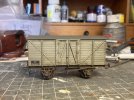You are using an out of date browser. It may not display this or other websites correctly.
You should upgrade or use an alternative browser.
You should upgrade or use an alternative browser.
4mm An EM Workbench: Mini-Signwriting (rough)
- Thread starter AJC
- Start date
I think the brake rodding is very noticeable, I do a representation on most of mine, if only because my layout track heights are around 55” (140cm in new money) off the floor.I don’t know about that, Matt, almost no one notices these things after a coat of paint - and you do that very nicely. Here’s one more, the first of the pair of dia. 1666.
View attachment 159264
This one has replacement W irons (Ambis) headstocks and brakes (a multitude) which sounds like more work than it was. It’s now in the queue for painting (bare metal and wood).
Adam
Unfitted Project: First Batch Finished
AJC
Western Thunderer
I’ve found time for a spot of weathering. The result is the first three finished unfitted opens.
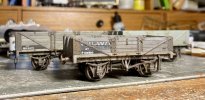
Wickwar Quarries can lay scant claim to this wagon, modelled a decade or so after nationalisation but unusually for an ex-PO vehicle this one survived in general merchandise use.
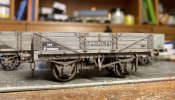
The other side of the same wagon - replicating what Don Rowland saw and pictured just prior to withdrawal - the word on the door is ‘asphaltic’: the vehicle was built for coated road stone.
Next, the LMS pair, a dia. 1666 (somewhat woebegone), and a dia. 1895 (really very tidy) which make a nice study in contrasts, I think.
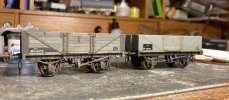
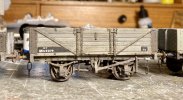
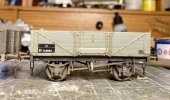
All in all quite satisfying in a monochrome sort of a way.
Adam

Wickwar Quarries can lay scant claim to this wagon, modelled a decade or so after nationalisation but unusually for an ex-PO vehicle this one survived in general merchandise use.

The other side of the same wagon - replicating what Don Rowland saw and pictured just prior to withdrawal - the word on the door is ‘asphaltic’: the vehicle was built for coated road stone.
Next, the LMS pair, a dia. 1666 (somewhat woebegone), and a dia. 1895 (really very tidy) which make a nice study in contrasts, I think.



All in all quite satisfying in a monochrome sort of a way.
Adam
Lyndhurstman
Western Thunderer
These are stunning, Adam. Beautiful and wonderfully rendered.I’ve found time for a spot of weathering. The result is the first three finished unfitted opens.
View attachment 159856
Wickwar Quarries can lay scant claim to this wagon, modelled a decade or so after nationalisation but unusually for an ex-PO vehicle this one survived in general merchandise use.
View attachment 159857
The other side of the same wagon - replicating what Don Rowland saw and pictured just prior to withdrawal - the word on the door is ‘asphaltic’: the vehicle was built for coated road stone.
Next, the LMS pair, a dia. 1666 (somewhat woebegone), and a dia. 1895 (really very tidy) which make a nice study in contrasts, I think.
View attachment 159858
View attachment 159859
View attachment 159860
All in all quite satisfying in a monochrome sort of a way.
Adam
Cheers
Jan
Unfitted Project: another pair
AJC
Western Thunderer
Thank you everyone, you’re all very kind. Here’s a couple of works in progress, paint still wet on the first one.
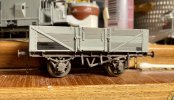
This is an ex-GWR O24 from an ABS kit. I’ve replaced the axleboxes, and added capping strips but that’s it. I gave it a coat of a weathered wood mix earlier and now some freight grey on the ironwork and some of the planks and some black number patches. I’ll let it harden off for a few days before I sort out lettering and weathering.
The second is the first wagon I’ve built where the kit has been supplanted by an RTR version! A SECR seven-plank from a Cambrian kit, this one is based on a published photo of a vehicle toward the end of its days but in decent order. I need to add some rust to the strapping and weather the under frame.
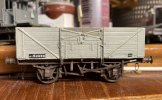
Adam
EDIT - as a PS, for those of you not following the production of 00 RTR wagons, here you go: Rapido Trains UK SECR 5 and 7 plank wagons in 00 arrive. - the RTR examples come in at about three times the cost of the kit and wheels. I reckon that, for the quality, that's good value in this instance.

This is an ex-GWR O24 from an ABS kit. I’ve replaced the axleboxes, and added capping strips but that’s it. I gave it a coat of a weathered wood mix earlier and now some freight grey on the ironwork and some of the planks and some black number patches. I’ll let it harden off for a few days before I sort out lettering and weathering.
The second is the first wagon I’ve built where the kit has been supplanted by an RTR version! A SECR seven-plank from a Cambrian kit, this one is based on a published photo of a vehicle toward the end of its days but in decent order. I need to add some rust to the strapping and weather the under frame.

Adam
EDIT - as a PS, for those of you not following the production of 00 RTR wagons, here you go: Rapido Trains UK SECR 5 and 7 plank wagons in 00 arrive. - the RTR examples come in at about three times the cost of the kit and wheels. I reckon that, for the quality, that's good value in this instance.
Last edited:
Unfitted Project: SECR open
AJC
Western Thunderer
And another one finished. It took a little longer than simply weathering the new Rapido model (and now the casual observer will conclude that's what I've done), but never mind, I'm reasonably happy with this one with a thin coat of grey over worn wood or SR brown, towards the very end of its service life (before being flogged off to the Port of Bristol, perhaps!).
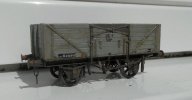
The reason why the Rapido model might score is the interior detail - Cambrian use raised lines for planks which I sanded off and then reinstated the bolt heads (as this rather red-shifted image shows):
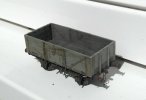
Adam

The reason why the Rapido model might score is the interior detail - Cambrian use raised lines for planks which I sanded off and then reinstated the bolt heads (as this rather red-shifted image shows):

Adam
OzzyO
Western Thunderer
Hello Adam,
fantastic work, but I'm sorry to say that like a lot of wagon and loco builders the couplings are letting the build down. The real thing was about 1" dia. steel and about 10" long so a big bit of kit when you had three of them.
The photo is of a M.R. coupling but most of them were about the same.
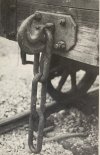
ATB
OzzyO.
PS I'll see if I can find a drawing of a coupling showing the sizes.
fantastic work, but I'm sorry to say that like a lot of wagon and loco builders the couplings are letting the build down. The real thing was about 1" dia. steel and about 10" long so a big bit of kit when you had three of them.
The photo is of a M.R. coupling but most of them were about the same.

ATB
OzzyO.
PS I'll see if I can find a drawing of a coupling showing the sizes.
AJC
Western Thunderer
Hello Ozzy
You’re right in some ways that the couplings are not a scale representation - the links are wider and longer than scale, but being made of 0.45 tinned copper wire they scale out at 1 1/2” which is about right.
They are made this way to make them usable in operation - scale couplings really necessitate spring buffers and a steadier hand and keener eye than I have (Exactoscale used to supply them) - but I agree it does show in photos.
Adam
EDIT: RCH drawings, including coupling components, including the links - total length just a smidge over 2' 6"section 1 1/5" - here: Railway Clearing House wagons
You’re right in some ways that the couplings are not a scale representation - the links are wider and longer than scale, but being made of 0.45 tinned copper wire they scale out at 1 1/2” which is about right.
They are made this way to make them usable in operation - scale couplings really necessitate spring buffers and a steadier hand and keener eye than I have (Exactoscale used to supply them) - but I agree it does show in photos.
Adam
EDIT: RCH drawings, including coupling components, including the links - total length just a smidge over 2' 6"section 1 1/5" - here: Railway Clearing House wagons
Last edited:
Dog Star
Western Thunderer
Stephen (@Compound2632),The photo is of a M.R. coupling but most of them were about the same.
View attachment 160674
Paul (@OzzyO) says in his post that the photo is of a MR wagon, just for interest let us say a D299. What is your take on the coupling hook with the intaglio arc feature?
regards, Graham
AJC
Western Thunderer
Stephen (@Compound2632),
Paul (@OzzyO) says in his post that the photo is of a MR wagon, just for interest let us say a D299. What is your take on the coupling hook with the intaglio arc feature?
regards, Graham
Mine is that it’s a later replacement - these forged items are (and if anyone can tell me if I’m right or wrong, please do), a late LMS and BR thing. But coupling hooks and links, like axleboxes, were consumables, so it’s no great surprise.
Adam
Compound2632
Member
Having been summoned by Graham, here's my 2d's worth: If this is a Midland wagon, the steel end stanchions point to it being a D663A 10 ton merchandise wagon or a D673 12 ton mineral wagon, in either case built post-Great War. The drawbar plate is not of Midland pattern, which was square, and I think the pattern of the larger diameter bolts - in fact the ends of the longitudinal bracing rods that go through to the middle bearers - being place diagonally is un-Midland. (Although I'm not certain about wagons to D673.) So I'm inclined to agree with @AJC that if this is an ex-Midland wagon, these are replacement parts - perhaps the headstock and some other frame members were replaced after an accident.
For myself, I've ceased to worry whether my three-links hang straight:
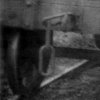
[The wagon in question is a Midland D299 8 ton open, photographed 1890s/early 1900s.]
Those links look a bit more like the Slaters ones I use, only without the gap you're supposed not to notice.
For myself, I've ceased to worry whether my three-links hang straight:

[The wagon in question is a Midland D299 8 ton open, photographed 1890s/early 1900s.]
Those links look a bit more like the Slaters ones I use, only without the gap you're supposed not to notice.
AJC
Western Thunderer
Thanks Stephen! My reckoning (because the details are correct for one, and the odds are in favour) is that the wagon pictured is an LMS dia. 1666. The hook would also be a replacement - these things did break from time to time.
Adam
PS - I make my own links from tinned copper wire wound round a former, soldered. About seven quid for an entire modelling lifetime of coupling links.
Adam
PS - I make my own links from tinned copper wire wound round a former, soldered. About seven quid for an entire modelling lifetime of coupling links.
Last edited:
Compound2632
Member
Adam, Yes, drawing here: The Midland Railway Study Centre - Carriage & Wagon drawings for downloading (second page). It is a good match.
SR vanfit
AJC
Western Thunderer
And now - because I’m out of a couple of key weathering colours - time for another wagon. This time a SR plywood van from a Ratio kit with one of the Southern’s idiosyncratic forms of vacuum brake. More of the latter anon, but tonight I’ve fitted the roof. The problem all the Ratio SR vans have is the roof moulding: it’s the right shape but too wide by just shy of 1mm. Being an awkward three arc profile, I decided the easiest way forward was to cut it in half and trim a bit off the cut edge before sticking a filch piece underneath and offering each half up in turn.
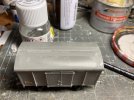
There’s a good solid support down the centre line to resist bowing and strip along the top edge of the side - you can’t see it but it’ll pay dividends at the painting stage - and vent holes drilled in the floor.
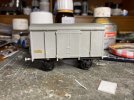
Side on, some extra details (Rumney Models) and a non-Ratio chassis because my prototype had BR W irons. Best leave that to set for a bit…
Adam
EDIT - I've just found a picture of a bit of another one - note that the chalk board is in a slightly different position:

There’s a good solid support down the centre line to resist bowing and strip along the top edge of the side - you can’t see it but it’ll pay dividends at the painting stage - and vent holes drilled in the floor.

Side on, some extra details (Rumney Models) and a non-Ratio chassis because my prototype had BR W irons. Best leave that to set for a bit…
Adam
EDIT - I've just found a picture of a bit of another one - note that the chalk board is in a slightly different position:
Last edited:
SR vanfit
Yorkshire Dave
Western Thunderer
Does it require a rework of Aaron Copland's - Fanfare for the Common......?
How will you disguise the roof join - fill, smooth and cover it with a single ply of plain toilet tissue and trim afterwards?
How will you disguise the roof join - fill, smooth and cover it with a single ply of plain toilet tissue and trim afterwards?
SR vanfit
AJC
Western Thunderer
How will you disguise the roof join - fill, smooth and cover it with a single ply of plain toilet tissue and trim afterwards?
I’ll see how the filler takes. Texture in 4mm is painfully easy to overdo, so I’ll have to see how it looks. As for a fanfare, it depends how it turns out…
Adam
Ex-GER Van by Oxford

